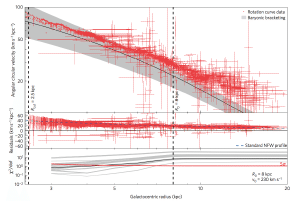Blog
Moving in the Dark
13 February 2015
 Serge Brunier / NASA
Serge Brunier / NASADespite all its mystery, dark matter is a central part of cosmology because it agrees with observation. The dark matter model makes specific testable predictions, such as gravitational lensing around colliding galaxies, and the clustering of galaxies on large scales. It also agrees with rotational motion of gas and stars in galaxies like the Milky Way, which is what motivated the idea in the first place. Of course the effect of dark matter on stellar motion in our galaxy has largely been in the outer region. If dark matter is real, we should also see its gravitational effect closer to galactic center. Well, now we have.
 Nature/Fabio Iocco, et al
Nature/Fabio Iocco, et alThe reason it’s so difficult to detect the effects of dark matter in the center of our galaxy is that it is dominated by regular (baryonic) matter. There’s a lot of stars, gas and dust in the central region, and accounting for the gravitational effects of all of it is a challenge. But over the past several years we have a much better map of the distribution of matter in the region, which is where this new work comes in. The results have been published in Nature Physics, and it compares the rotational motion of the galaxy near the center with its predicted motion due to known baryonic matter.1 From this the authors found that the observed motion of central material in our galaxy does not agree with the predicted gravitational motion due to the matter in the region. So either there is dark matter in the region, or our understanding of gravity is wrong.
While there are still some who propose a modified gravity approach, it doesn’t work on large scales, unlike dark matter. This new result is exactly what we’d expect to see with dark matter, so it’s one more bit of evidence to support the model. What’s more, by observing the effect of dark matter in the center of the Milky Way, we now have an opportunity to further distinguish between different types of dark matter. Different dark matter models predict different distributions of dark matter in the galaxy, so with further observation we should be able to eliminate more models from the pool of candidates.
Iocco, Fabio, Miguel Pato, and Gianfranco Bertone. “Evidence for dark matter in the inner Milky Way.” Nature Physics 11.3 (2015): 245-248. ↩︎